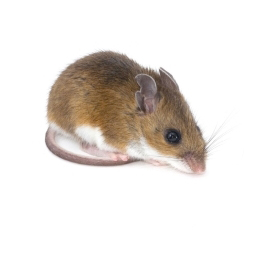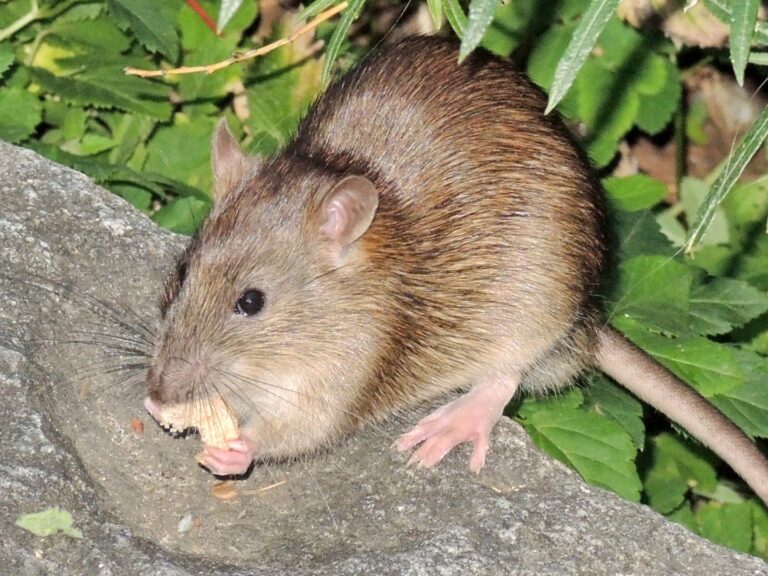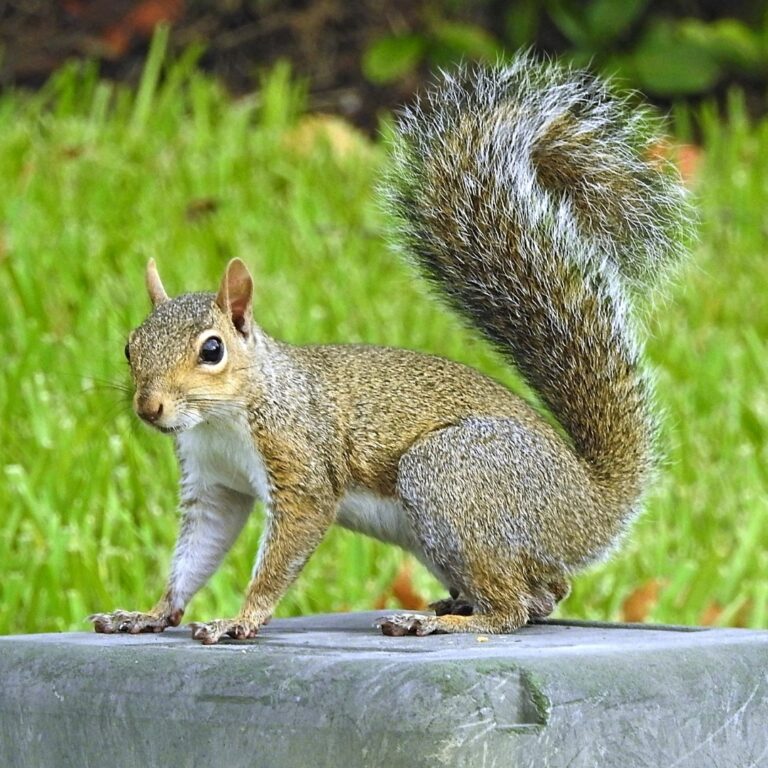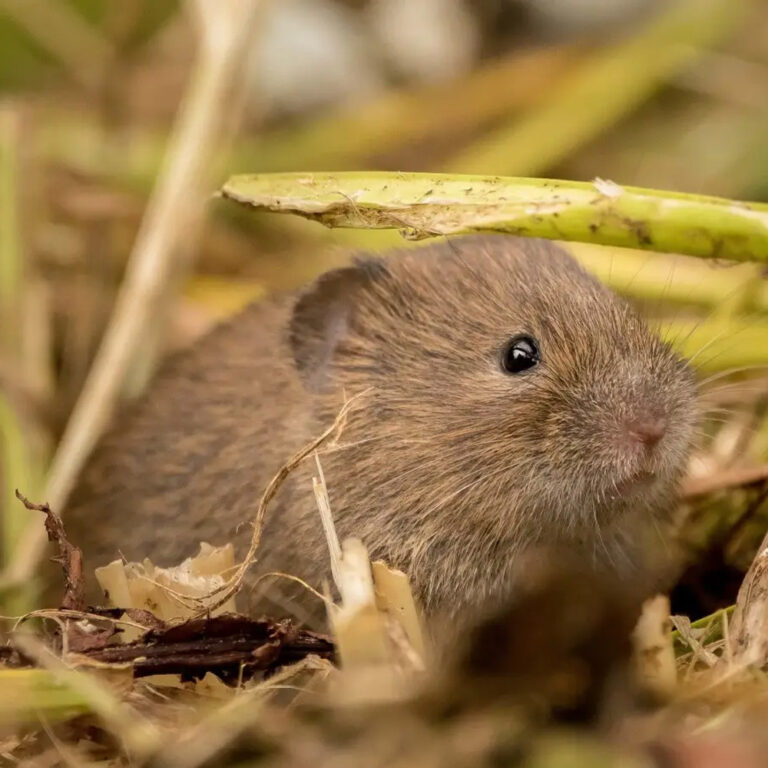Muskrat
What is a Muskrat?
The common muskrat (Ondatra zibethicus) belongs to the Muridae family and is known for its semi-aquatic lifestyle. Native to North America, this animal prefers wet environments like ponds, marshes, and riverbanks, where it builds distinctive lodges. Its diet mainly consists of aquatic vegetation, but it can also consume small fish and crustaceans. Risks associated with its presence include damage to hydraulic and agricultural infrastructures, as well as potential negative impacts on water quality and local biodiversity.
How to Identify Muskrats?
Muskrats are easily identifiable by several unique physical features that distinguish them from other rodents. Their robust bodies and distinctively flattened tails, used as rudders when swimming, make them excellent swimmers. Their hind legs are partially webbed, aiding their movement in water, while their brown fur camouflages them in their natural habitat.
Adults can reach up to 60 cm in length, including the tail, and weigh around 1.5 kg, making them one of the largest members of their family in many regions.
Telltale signs of their presence, such as lodges built from vegetation in water bodies, slide marks along banks, and visible damage to aquatic plants or crops near water habitats, indicate not only their presence but also the need for interventions to manage or eliminate infestations. These interventions can include habitat strategies and population control designed to minimize their environmental impact while protecting properties and agricultural areas from damage.

Additional Information on Muskrats
Pest Type
The common muskrat is a semi-aquatic rodent known for its impact on aquatic ecosystems and wetlands, where it can become a pest in case of overpopulation.
Appearance
With a robust body adapted to aquatic life, a flattened tail used as a rudder when swimming, and webbed hind feet for better propulsion, the muskrat is perfectly equipped for its semi-aquatic environment.
Lifespan
In the wild, muskrats typically live 3 to 4 years, reflecting their ability to survive despite predators and sometimes harsh habitat conditions.
Habitat
Preferring wet environments, muskrats are often found in marshes, ponds, and rivers, where they build distinctive lodges as shelters.
Diet
Their diet consists mainly of aquatic vegetation but can also include small fish and crustaceans, showcasing their adaptability.
Life Cycle
Capable of having multiple litters per year, with each litter consisting of 6 to 8 young, muskrats can quickly increase in number under favorable conditions, highlighting the importance of effective management and control to maintain their population at a balanced level.
Do I Have a Muskrat Problem?
If you notice damage to banks, lodges in your water bodies, or signs of consumed aquatic vegetation, Exterminapro intervention is recommended for effective and environmentally respectful elimination. Don’t wait for the damage to worsen; act now to protect your property.
Signs of a Muskrat Infestation
- Damage Types: The erosion and subsidence of banks and water retention structures caused by muskrat tunnels and lodges can have severe consequences for the stability and safety of wetlands.
- Presence: The presence of conical or spherical structures built in water bodies from cut vegetation is often a clear indicator of muskrat activity.
- Vegetation Consumption: Areas stripped of aquatic plants near water bodies suggest that muskrats are feeding and may indicate the location of their activity zones.


Risks Associated with Muskrats
In addition to causing significant damage to hydraulic infrastructures and crops, threatening the stability of banks and increasing the risk of floods and agricultural losses, muskrat activity can severely disrupt local ecosystems. These semi-aquatic rodents can alter aquatic habitats in ways that negatively affect local wildlife, reducing biodiversity and water quality by destroying aquatic vegetation and introducing sediments into waterways.
This disruption can have a cascading effect on the entire ecosystem. Professional management and eradication by Exterminapro can help prevent these negative environmental impacts, using environmentally friendly extermination methods to effectively control muskrat populations and protect natural habitats and agricultural areas.
Treatments to Get Rid of Muskrats
Eliminating muskrats requires a specific approach, including trapping, habitat modification to make areas less attractive to them, and, in some cases, the controlled use of repellents or wildlife management techniques.
Preventing Muskrat Infestations
- Vegetation Management: Maintaining clear banks and proactive management of aquatic vegetation can significantly reduce the preferred habitat of muskrats. By limiting their access to food and building materials for their lodges, their ability to establish and reproduce is diminished.
- Water Level Control: Adjusting water levels in ponds, marshes, and waterways can disrupt the ideal conditions for muskrat lodge construction, encouraging them to seek less disturbed habitats.
- Physical Barriers: Installing fences or specially designed grates around sensitive areas, such as gardens or riverbanks, can physically prevent muskrats from accessing these spaces and causing damage.
Types of Treatments to Control Muskrats
- Selective Trapping: Using specific traps, such as cage or clapper traps, allows for humane and effective muskrat capture. This method enables targeted removal without affecting other local wildlife species, ensuring that only problematic individuals are removed from the environment.
- Repellents: Applying natural or chemical repellents designed to deter muskrats without harming them represents an environmentally friendly approach. These repellents can alter muskrat behavior by making treated areas less attractive to them.
- Habitat Restoration: Engaging in ecological techniques to restore and maintain natural ecosystems can significantly reduce the attractiveness of areas to muskrats. This may include planting native vegetation and managing water to create less favorable conditions for their proliferation.
How to Permanently Eradicate Muskrats?
The key to sustainably controlling muskrat populations lies in the combined use of professional extermination methods and environmental management practices. Exterminapro is at your disposal to provide tailored solutions, ensuring the protection of your property while preserving the local ecological balance.
Intervention Process
How Much Does It Cost?
Get a Free Estimate
The cost of muskrat extermination depends on the extent of the infestation and the treatment methods employed. Exterminapro offers a free evaluation to determine the most suitable strategy for your situation. Contact us now to secure your property against these aquatic pests.







